As the sun rises, a symphony of chirping, tweeting, and singing fills the air; it’s the morning chorus of birds. Birds are fascinating creatures that begin their day with exuberance and energy.
They come in all shapes, sizes, and colors; each species has its unique voice and behavior. For bird enthusiasts, morning is the perfect time to observe and listen to the varied bird calls.
Some birds can be spotted fluttering from tree to tree, seeking their breakfast, while others glide effortlessly across the sky, searching for a new habitat.
In this article, we will explore the world of birds in the morning and celebrate the beauty and wonder they bring to our world.
10 Birds That Calls In The Morning
Morning is a delightful time for bird enthusiasts, as many bird species are most vocal at dawn. Here are ten birds known for their morning calls:
1. American Robin

The American robin is a migratory bird belonging to the true thrush genus and Turdidae family.
It was named after its European counterpart due to the similar reddish-orange breast they possess; however, they are not closely related.
This species can be seen through most of North America during winter months and in parts of Mexico and Central America, where it also breeds.
They have plump bodies with gray upperparts and white underparts that vary from yellow on their throats down to orange toward their bellies.
Robins feed on fruits such as berries or insects like worms, making them an important part of ecosystems by helping disperse seeds naturally throughout these areas.
Scientific classification:
| Kingdom | Animalia |
| Phylum | Chordata |
| Class | Aves |
| Order | Passeriformes |
| Family | Turdidae |
| Genus | Turdus |
| Species | T. migratorius |
Also Featured In: Most Common United States Birds, Most Common Winter Birds
2. Baltimore Oriole
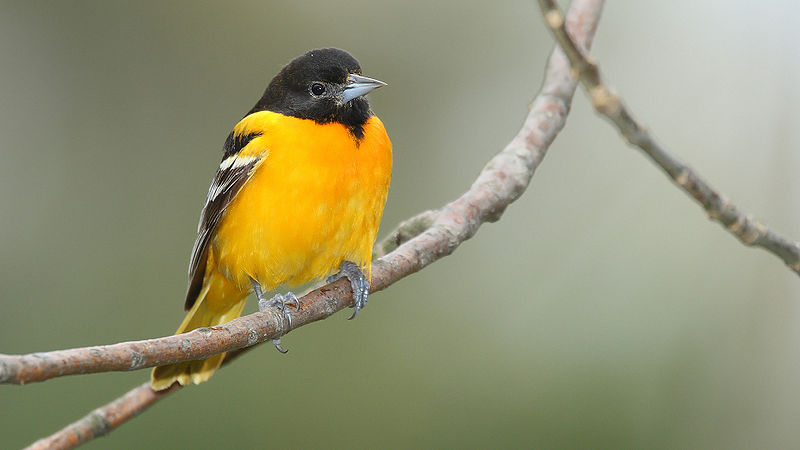
The Baltimore Oriole is a small, blackbird-like bird found in eastern North America. It’s named for the resemblance of its male colors to those on Lord Baltimore’s coat-of-arms from the 17th century.
These birds migrate and breed during springtime and are quite common in their habitats.
Studies have shown that this species interbreeds with western Bullock’s orioles, classifying both as a single species – Icterus galbula.
The males typically have orange feathers along the chest, back, wings, and tail, while females display tan or yellowish shades instead of bright orange-like males.
Both sexes share white wing bars and dark brown eyes, making them easily distinguishable from other birds.
They can often be seen flitting around trees, feeding off nectar buds or insects such as grasshoppers & caterpillars they catch while flying around.
Scientific classification:
| Kingdom | Animalia |
| Phylum | Chordata |
| Class | Aves |
| Order | Passeriformes |
| Family | Icteridae |
| Genus | Icterus |
| Species | I. galbula |
Also Featured In: Birds Commonly Found in New York, Birds Live in Arkansas
3. Tufted Titmouse

The Tufted Titmouse is a small, cheerful songbird found in North America. It’s part of the tit and chickadee family (Paridae).
It has distinctive white feathers around its eyes, grey-brown wings, and upper body, with a pale tan underside.
Its most notable feature is the black crest on top of its head, which gives it an inquisitive look. The male also sports a pinkish breast, which can be seen.
When singing from high perches during the spring months. This bird loves to eat sunflower seeds or suet at backyard feeders and insects in summertime.
You may even see them poking into crevices and bark, looking for food.
They are quite social birds, too, being often spotted in mixed flocks alongside other species, such as nuthatches and woodpeckers, all year round.
Scientific classification:
| Kingdom | Animalia |
| Phylum | Chordata |
| Class | Aves |
| Order | Passeriformes |
| Family | Paridae |
| Genus | Baeolophus |
| Species | B. bicolor |
Also Featured In: New Hampshire Birds You Should Know, Birds that Migrate through Illinois in the Spring
4. Red-Winged Blackbird

The red-winged blackbird is a beautiful bird found in most of North America and Central America.
Its distinct features include a glossy black body, with white shoulder patches and bright red wing coverts year round.
It prefers wetland habitats such as marshes, ponds, lakeshores, and agricultural fields. During breeding season, they inhabit grassy areas near water, then move south for the winter months.
For food, they mainly eat insects but also consume wild fruit or grains.
They are very social birds, often seen in large flocks during migration times when their unmistakable “conk-la-ree” call can be heard echoing across the sky.
Scientific classification:
| Kingdom | Animalia |
| Phylum | Chordata |
| Class | Aves |
| Order | Passeriformes |
| Family | Icteridae |
| Genus | Agelaius |
| Species | A. phoeniceus |
Also Featured In: Flocks Birds around Us, Birds That Live in Colorado
5. Chipping Sparrow
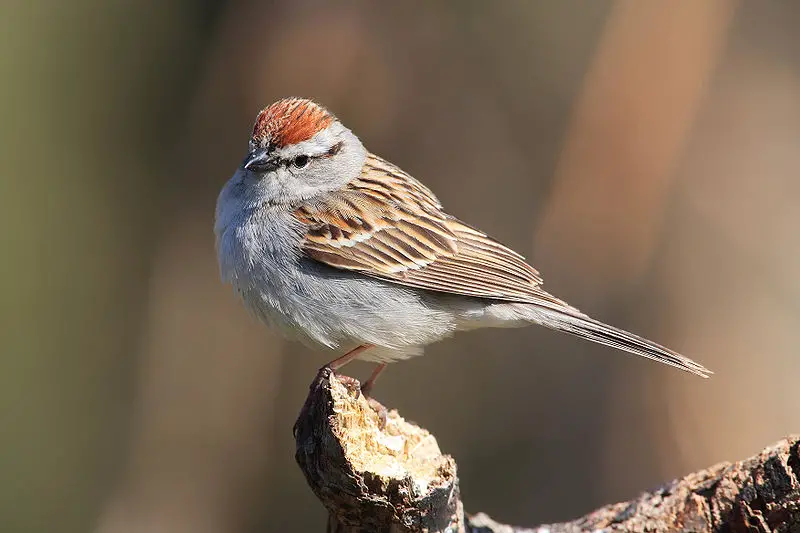
The Chipping Sparrow is a small passerine bird in most of North America. It has two subspecies, the eastern and western chipping sparrows, which migrate seasonally to overwinter in warmer climates.
The birds are grey above with white underparts, have a rufous cap with black stripes, and large eyes surrounded by light brown feathers.
They feed mainly on seeds but can also be seen eating insects during breeding season when raising their young chicks.
These intrepid little birds live in open grasslands such as prairies or meadows, building cup-shaped nests in trees or shrubs to raise their young family.
Their cheerful song often sounds like ‘chips,’ hence its name: Chipping Sparrow.
Scientific classification:
| Kingdom | Animalia |
| Phylum | Chordata |
| Class | Aves |
| Order | Passeriformes |
| Family | Passerellidae |
| Genus | Spizella |
| Species | S. passerina |
Also Featured In: Most Popular Bird Species in North America, Common Birds in Saskatchewan
6. Common Chaffinch

The Common Chaffinch is a beautifully colored small passerine bird from the finch family.
The males have striking blue-grey caps and rust-red underparts, while the females are more subtle in their coloring, but both possess two distinct white wing bars and white sides on their tails.
This gorgeous bird has an incredibly strong voice which can be heard for miles as it sings from exposed perches during mating season.
It lives mainly throughout Europe but also in parts of North Africa and Asia too, favoring woodland areas with plenty of shrubs or trees nearby where they find shelter amongst foliage when needed.
They feed predominantly on seeds from weeds or grains found within grasslands, making them particularly useful birds for farmers who rely heavily upon pest control that these little ones provide.
Scientific classification:
| Kingdom | Animalia |
| Phylum | Chordata |
| Class | Aves |
| Order | Passeriformes |
| Family | Fringillidae |
| Subfamily | Fringillinae |
| Genus | Fringilla |
| Species | F. coelebs |
Also Featured In: Birds of United Kingdom, Turkey Birds You Should Know
7. Common Chiffchaff
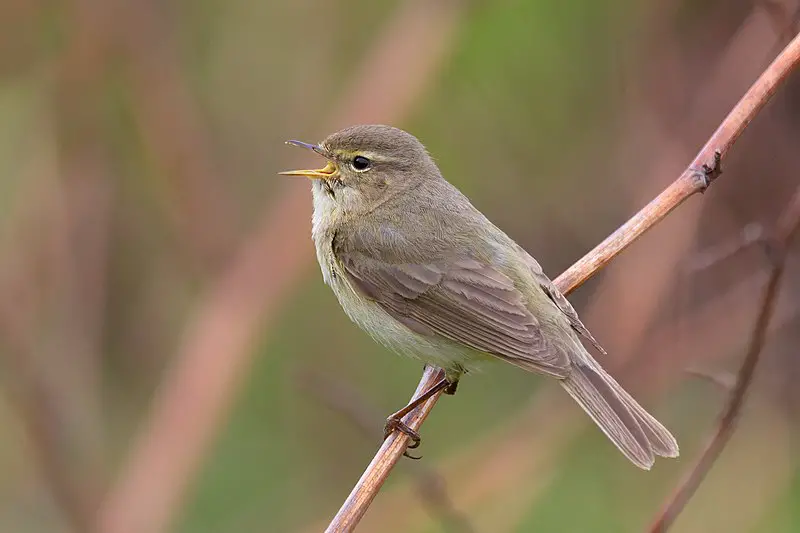
The Common Chiffchaff is a small bird found in northern and temperate Europe and the Palearctic.
It has greenish-brown plumage on its upper parts, off-white feathers beneath, and gets its name from an onomatopoeic call that resembles “chiff chaff”.
This migratory passerine breeds in open woodlands during summer before heading to southern Asia, western Europe, and North Africa for winter.
A frequent visitor at gardens with good insect supplies, it feeds mainly on insects such as flies, beetles, or ants, which are caught by gleaning foliage or hawking aerial prey.
Despite being one of Britain’s most common birds – estimated numbers between 6–9 million pairs – their population numbers have declined over recent years due to habitat destruction caused by climate change.
Scientific classification:
| Kingdom | Animalia |
| Phylum | Chordata |
| Class | Aves |
| Order | Passeriformes |
| Family | Phylloscopidae |
| Genus | Phylloscopus |
| Species | P. collybita |
Also Featured In: Gujarati Birds, Birds that can be Seen in October
8. Song Thrush
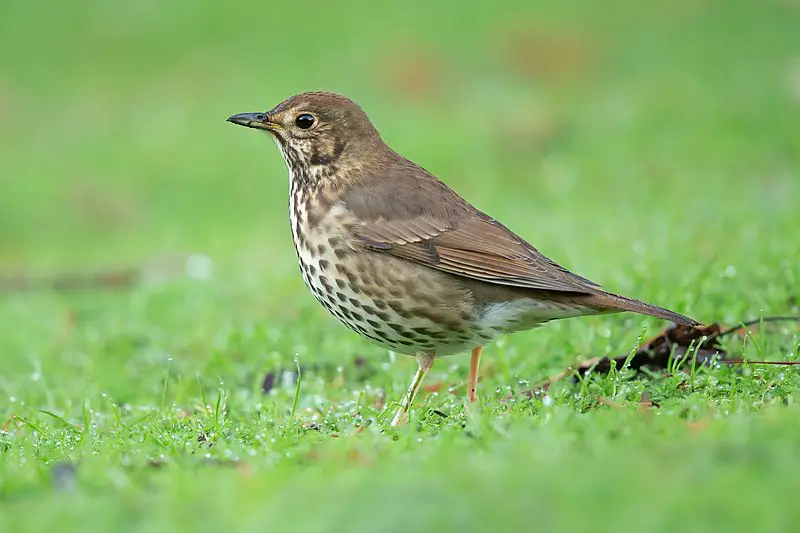
The Song Thrush is a beautiful bird that breeds across the West Palearctic. It has brown upperparts and creamy or buff underparts with black spots and three recognized subspecies.
Its vocalizations are particularly melodious; its song consists of repeated musical phrases, hence why it has been referenced often in poetry.
This species can be found breeding in forests, gardens, and parks during summertime months before migrating elsewhere for winter.
With its attractive plumage and lovely singing voice, it’s no wonder this thrush is so beloved by many.
Scientific classification:
| Kingdom | Animalia |
| Phylum | Chordata |
| Class | Aves |
| Order | Passeriformes |
| Family | Turdidae |
| Genus | Turdus |
| Species | T. philomelos |
Also Featured In: Common Birds in the Cities, European Birds
9. American Yellow Warbler
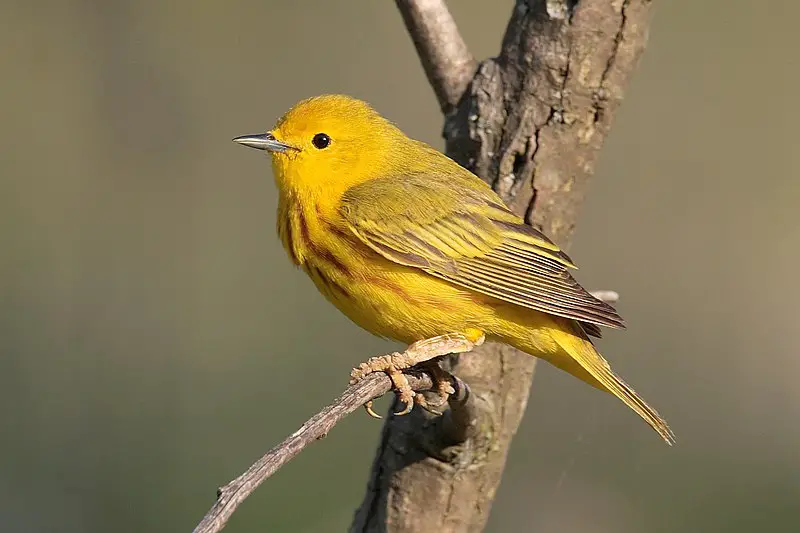
The American Yellow Warbler (Setophaga petechia) is a species of New World warbler found across North America, the Caribbean, and northern South America.
Its genus name, Setophaga, comes from Ancient Greek words meaning “moth” and “eating,” while its specific name, Petechia, originates from Italian for small red spots.
This bird has striking yellow plumage with reddish-brown streaks on their chest that can be seen during mating season when they are most colorful.
They live in open woodlands near wetlands or bodies of water where they can find food such as insects like spiders, beetles, and caterpillars, which comprise much of their diet.
The male will sing to attract a mate during the breeding season before setting up a home in twig nests built by both sexes together high in trees or shrubs.
Scientific classification:
| Kingdom | Animalia |
| Phylum | Chordata |
| Class | Aves |
| Order | Passeriformes |
| Family | Parulidae |
| Genus | Setophaga |
| Species | S. petechia |
Also Featured In: Utah Birds, Most Common Songs Birds that Live around You
10. Gartered Trogon
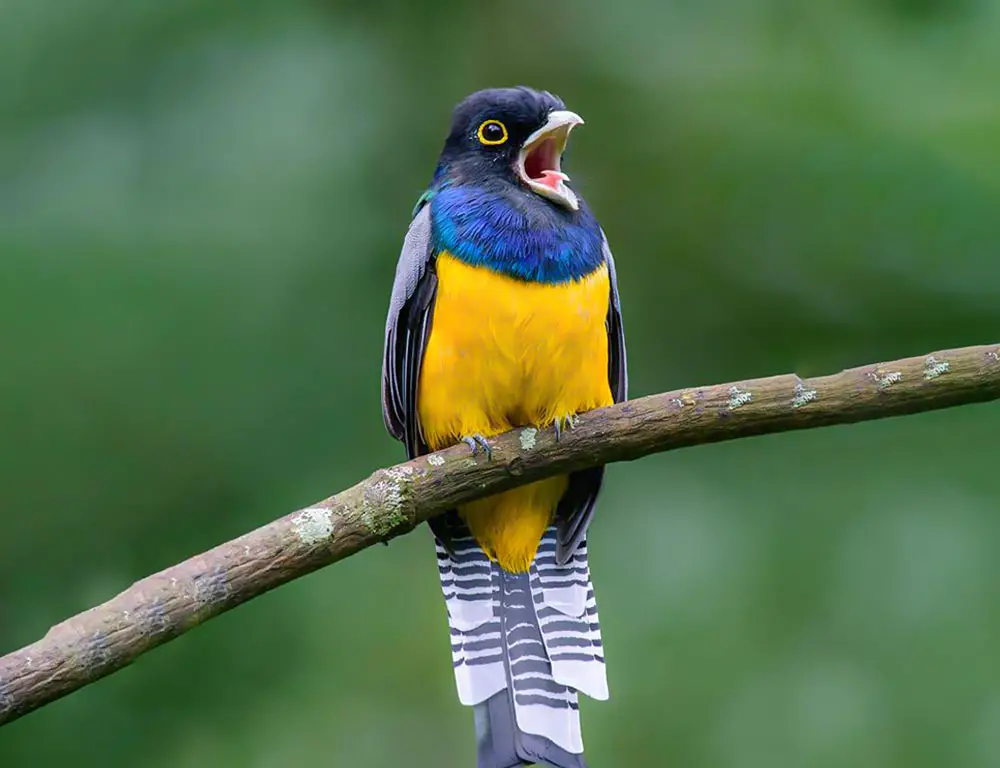
The gartered trogon, also known as the northern violaceous trogon, is a species of bird found in several countries in Central and South America. It belongs to the family Trogonidae and is closely related to quetzals.
Up until recently, it was considered a subspecies of the violaceous trogon. The gartered trogon is known for its brightly colored plumage, which includes a striking mix of blue, green, and purple hues.
While primarily found in forested areas, this bird can also be seen in gardens and parks.
It feeds on insects and small fruits and is known for its distinctive call. Despite facing habitat loss and fragmentation, the gartered trogon remains widespread and is classified as a species of least concern by the IUCN Red List.
Scientific classification:
| Kingdom | Animalia |
| Phylum | Chordata |
| Class | Aves |
| Order | Trogoniformes |
| Family | Trogonidae |
| Genus | Trogon |
| Species | T. caligatus |